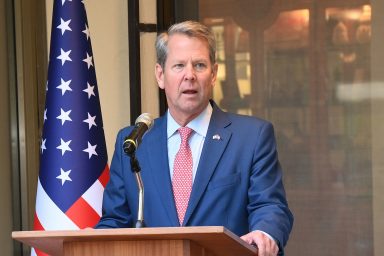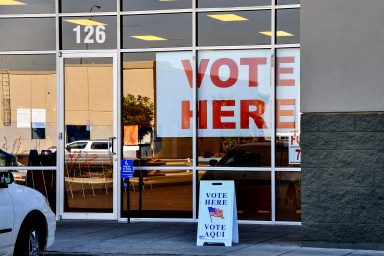WhoWhatWhy’s Election Integrity Weekly is written by Gabriella Novello, and edited by William Dowell and Sue Rushford. Have a tip or want to suggest a story? Send us an email at ei@whowhatwhy.org.
Does Your School Rank? We have an exciting announcement to make! Our talented team of reporters and editors at WhoWhatwhy have rolled out our first-ever Student Voter Guide, ranking the nation’s top-rated universities on how easy or hard it is to cast a ballot on campus.
Of course, this year is different. Many universities have told their students to stay home and rely on remote learning. But when things do get back to normal, will students be able to vote between classes? Will universities help students navigate their state’s laws to register and participate in the democratic process?
Our Student Voter Guide not only ranks universities on the number of on-campus polling places, student voting rates, and the number of polling sites within five miles of campus, but it also equips prospective students with the information they need to consider university voter policies when applying for college.
A total of 76 schools have been included in this analysis. Find out whether your university made the cut. (read more)
What Will Student Turnout Look Like? The short answer: potentially bleak.
Studies show that turnout is greater when students can vote in person on campus. WhoWhatWhy’s Student Voter Guide analyzed 76 colleges and universities and found that 73 percent of the institutions looked at provided on-campus polling stations on election day in November 2016. That percentage will be lower in the election this November since most universities won’t be sponsoring voter registration drives and, in any case, on-campus polling sites will effectively be useless for students who stayed home for the fall semester. (read more)
Today is National Voter Registration Day: If you are not sure whether you registered to vote, check your state’s deadline here and make a plan to register and vote.
Upcoming Project Announcement: After a months-long investigation, WhoWhatWhy will be releasing an ebook next week that takes a deep dive into the voting machine industry and how the election infrastructure in the United States is vulnerable to manipulation.
Authored by Celeste Katz Marston and Gabriella Novello, Is This Any Way to Vote?: Vulnerable Voting Machines and the Mysterious Industry Behind Them, answers critical questions about voting machines, ranging from how they work, to who owns them, to how easily they can be hacked.
Available on Amazon and at WhoWhatWhy, starting Sept. 29. (preview here)
Detroit Gears Up for Record Mail-In Vote: Voter enthusiasm is up, but will Michigan — especially Detroit — be able to resolve a history of election issues?
In 2016, then-candidate Donald Trump surprisingly won Michigan by less than 11,000 votes. That was in part due to a breakdown in Detroit’s voting system and a much lower turnout than the one experienced in 2012. There are serious concerns this year about absentee ballot processing after 72 percent of precincts in Michigan’s largest city recorded absentee totals that did not match the number of ballots ultimately tabulated.
Although the discrepancies were small, Detroit Mayor Mike Duggan (D) reached out to Michigan Secretary of State Jocelyn Benson to investigate and ask for assistance. Detroit is now hiring thousands of poll workers and adding 14 satellite voting locations and 30 absentee ballot drop boxes to ensure that there are no issues this November. (read more)
Vote Counting, the ‘Blue Shift,’ and Electoral ‘Delay’: For most of our history the Electoral College worked as intended. It wasn’t until 1992, and then again in 2000 and 2012, that it went off the rails. However, it’s also possible that a straightforward national popular vote could be even more problematic than the system we have now.
In our latest podcast, WhoWhatWhy’s Jeff Schechtman spoke with Ohio State law professor and election expert Edward Foley on what to look for in the election results of 2020, and how long it may take them to come into focus. Foley warns that things may be different this time. In 2020, the “Blue Shift” could be more intense, or it might not happen at all. (listen here)
In the Courts
- League of Women Voters v. Kosinski: A settlement was reached in New York last week regarding absentee ballot signature requirements. Voters will have a more specific and transparent way to have their absentee ballot count if it is rejected. Prior to this settlement, a ballot could be rejected if there was an error with a voter’s signature or was submitted within a defected envelope.
- Michigan Alliance for Retired Americans, et al., v. Jocelyn Benson: A federal judge ruled that absentee ballots in Wisconsin can be counted up to six days after Election Day as long as they were postmarked by November 3. Current law requires voters to return an absentee ballot by 8pm on Election Day in order to be counted.
What We’re Watching
With Supreme Court Justice Ruth Bader Ginsberg’s passing, President Donald Trump and Senate Republicans are eager to nominate and confirm her replacement. House Speaker Nancy Pelosi (D-CA) will not rule out impeachment as a way to halt the process, although it remains unclear what reason House Democrats would provide in any articles of impeachment. (read more)
In the meantime, we’re reaching out to voters to see how an empty Supreme Court seat is impacting their enthusiasm for the 2020 election. It’s likely that turnout will increase even more among Democratic and Republican voters, but to what degree? Tell us your thoughts by sending us an email at ei@whowhatwhy.org.
WhoWhatWhy and Readers’ Picks of the Week:
- How ‘Naked Ballots’ in Pennsylvania Could Cost Joe Biden the Election (Philadelphia Inquirer)
- Third Parties Could Play a Lesser Role in 2020 Campaign (Seattle Times)
- The Details of Lawsuits Against Ohio Over Drop Boxes, Signatures and Electronic Ballot Requests (WKSU)
- Judge Dismisses Trump Campaign’s Lawsuit Over Nevada’s Expanded Mail Voting Law (Nevada Independent)
- Trump Campaign Still Appears to be Hiding Large-Dollar Payments to Kimberly Guilfoyle And Lara Trump (Salon)



